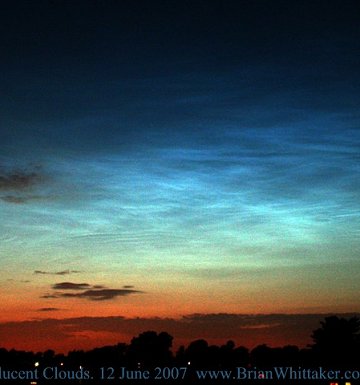 The space shuttle is docked to the ISS. Would you like a call when the pair fly over your backyard? Sign up for SpaceWeather PHONE. The space shuttle is docked to the ISS. Would you like a call when the pair fly over your backyard? Sign up for SpaceWeather PHONE. QUIET SUN: Solar activity is low. Sunspot 960 is departing over the sun's western limb and no longer poses a threat for solar flares. ISS FLARES: Yesterday, astronauts working outside the International Space Station unfurled a new pair of solar panels. A few hours later, ISS sailed over England where Mike Tyrrell photographed the expanding spaceship through his 10-inch Meade LX-200. The new panels are indicated by the arrow: 
Click to play the movie!
"I also saw a flare from the solar panels of a Russian Progress supply ship now docked to the ISS," notes Tyrrell. Several sky watchers have reported flares. "I stepped outside last night at 22:11 local time to watch ISS+Atlantis fly overhead," reports Mark James of Berkshire, England. "It was dusk so the sky was still dark blue. As the station went by, I was pleasantly surprised to see it become significantly brighter for a few seconds--a bit like an Iridium Flare." Meanwhile in the Czech Republic, Martin Popek photographed an "ISS flare" from his hometown of Nýdek: image. These flares are caused by sunlight glinting from flat surfaces on the station. With so many spaceships docked to ISS, and with new panels being unfurled, now is a good time to watch for these surges in brightness. The trick, of course, is knowing when to look. more images: from Ralf Vandebergh of the Netherlands; NLC WATCH: Last night, sky watchers in England witnessed a vivid display of noctilucent clouds. "It's the best display I've ever seen from my house in Birmingham," says veteran NLC-watcher Brian Whittaker who took this picture: 
"Did the recent shuttle launch contribute to these clouds?" he asks. Maybe. Studies show that shuttle launches can promote noctilucent clouds. Exhaust from the main engines of NASA’s space shuttle is about 97 percent water vapor, and this vapor can travel from Florida to the Arctic in little more than a day. There "it forms ice to create some of the Earth’s highest clouds that literally shine at night," according to scientists at the Naval Research Laboratory in Washington, DC: press release, original research. The space shuttle cannot be wholly responsible for NLCs, which were first sighted in the 19th century long before space travel. Shuttle launches may, however, be a contributing factor to modern displays. Another NASA spacecraft named AIM is orbiting Earth now on a mission to discover the underlying causes of these mysterious clouds. 2007 Noctilucent Photo Gallery
[Listen!] [Night-sky Cameras] | 
